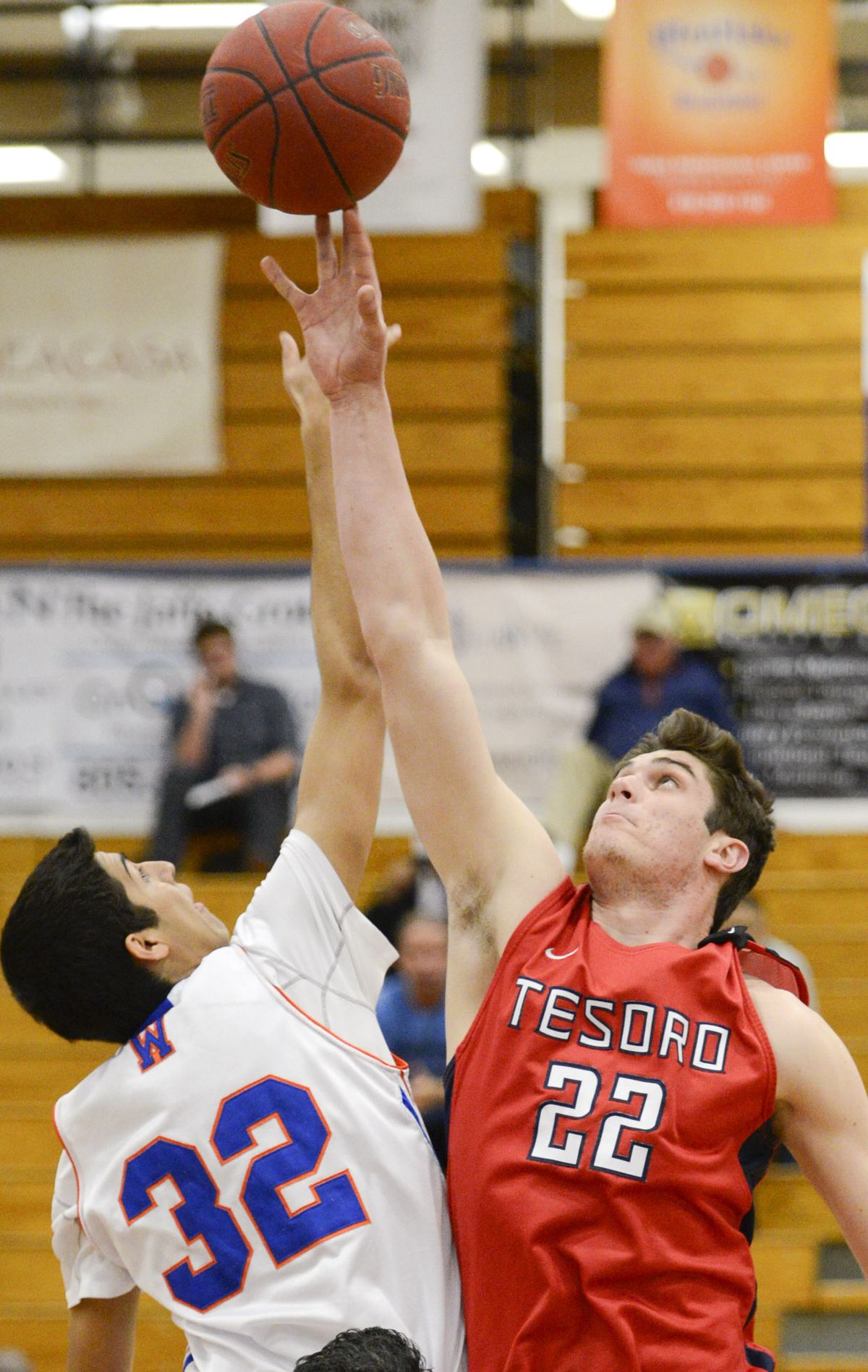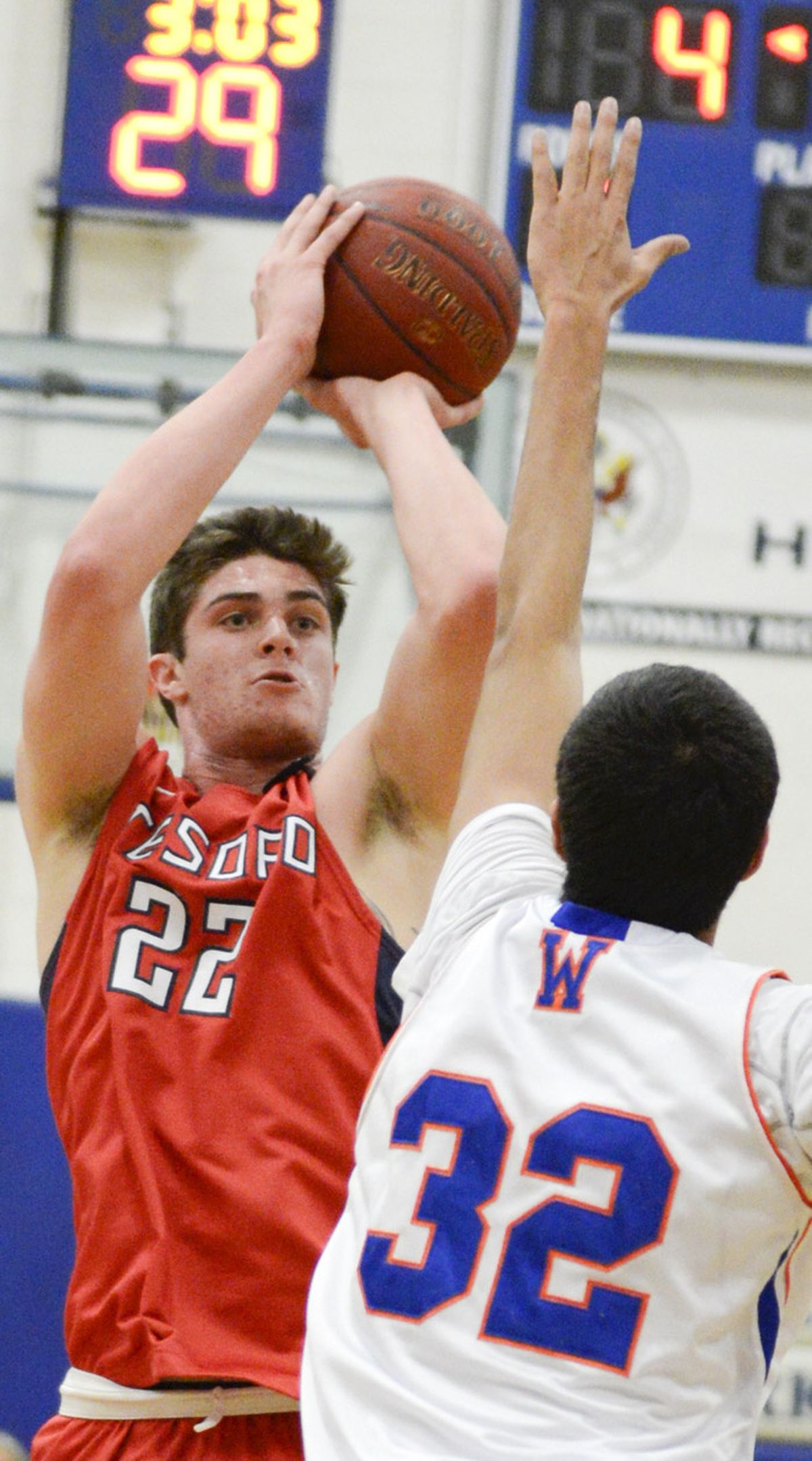Letters of intent, not of guarantees
Tanner Lancona wasn’t wanted by WSU, says the player’s father. (MICHAEL LOPEZ)
The tattoo has since been modified, and Sean Lancona says you can’t really see it when he wears his watch, anyway.
But once upon a time, back when Lancona believed his son, Tanner, was headed to Washington State to play basketball after he had signed a National Letter of Intent with the school in November, Sean wanted to celebrate.
First he purchased WSU merchandise, enough of it to outfit several members of Tanner’s family and friends and high-school coaches – shirts and hats and jackets and car stickers all around.
“Everybody got something,” Sean said.
The fullest measure of Sean’s excitement came later, with his left wrist under the needle, that needle inking a Cougar-head logo to commemorate the NLI ink-oath Tanner had signed.
Binding, both of those ventures. But in different ways. Tats are forever, though NLIs only guarantee enrollment and financial aid for one academic year at the school for which they’re signed.
Lancona’s situation, then, provides an interesting look into the machinations of one of the NCAA’s least understood processes – the National Letter of Intent and all it assures. And, sometimes, all that it doesn’t.
• • •
An NLI, interpreted at its most basic definition, is a binding agreement between a school and a prospective student-athlete that assures the player will be given an athletic scholarship for at least one full academic year.
It must be accompanied by a financial-aid agreement – walk-ons are not subject to or permitted to participate in the NLI program – and must be signed and dated within 14 days of its issuance by the athlete and, if he or she is under the age of 21, their legal guardian.
It is renewable at the end of each academic year, though a relatively new NCAA provision allows schools to extend multiyear guarantees at the time of signing. But schools also have the right not to renew a player’s scholarship once each academic year has ended.
What they don’t have the right to do, however, is terminate a signed NLI before the player arrives on campus.
And, technically, that is not what happened to Lancona. His release – granted at his request, technically – was handled above board. But there is a grayer area within the events preceding it.
Here’s how Sean, the father, tells it: Lancona was all-in on the Cougars, and he had the merchandise and Twitter posts to prove it.
Then one day in April, coach Ken Bone and assistant Ben Johnson flew to Southern California for a meeting at the Lancona home. Neither party will divulge the details of the 20- or 30-minute talk, but after it ended, Tanner posted on his Twitter page that he had “decommitted” from WSU and was reopening his recruitment.
Though it has never been explicitly stated as the reason Lancona didn’t end up at WSU, the Cougars did need to free up a scholarship to sign junior-college point guard Danny Lawhorn, which they eventually did.
At the time, Tanner called his departure a “mutual” decision between him and WSU. Tanner’s father was unequivocal in his contention of that notion.
“There was no choice in that matter,” Sean said. “It was happening with or without us.”
Not entirely, though. No school has the power to simply rescind a signed NLI, unless the student-athlete fails to meet NCAA or university eligibility requirements. It is binding, remember. Still, considerable pressure mounts upon a student-athlete who might not feel as if the school is as excited about the deal as he is.
“Once they sign it, it’s their scholarship,” Bone said. “But what I did do was revisit our program, the individual, and take a picture: This is where we see you. If you want to still be here, buy into it, great. But if you don’t, I just want you to understand the picture and where we see you in our program.”
Lancona didn’t see himself in WSU’s program after that April conversation – and Bone apparently flew down there in the first place because he didn’t see him there, either – so Lancona was granted his full release.
Fortunately for Lancona, there remains high demand for 6-foot-8 forwards with outside shooting ability. Saint Louis, Kansas State and several other schools contacted Lancona immediately. He eventually signed a financial-aid agreement with Saint Louis and will be on the Billikens’ roster this season.
WSU athletic director Bill Moos said he would prefer not to make a habit of shuffling signees out of the program before they enroll.
“The thing is, this is a tough business,” Moos said. “Jobs are on the line. We still need to hang onto our ethics, (and) in a perfect world, those things wouldn’t happen. My understanding was more that it was a mutual decision, and maybe it became a mutual decision after the conversation. Because of that, I was OK with it.”
• • •
The Lancona situation is odd, and some might say unfortunate. But in the end, he’ll be fine. He’s playing for a school with a quality basketball program that earned a No. 5 seed in the NCAA tournament last season, and he won’t have to forfeit any eligibility to do it.
But far more strife is created when a player wants to leave a school that wants him to stay.
Wes Lunt was a freshman quarterback for Oklahoma State’s football team last season. After that season ended, he decided he didn’t want to play at OSU anymore, so he sought his full release to transfer from the school.
What he received was instead a release with a whole bunch of caveats. He would be allowed to transfer. But not to another Big-12 school. Or an SEC school. The list of restrictions neared 40 teams, according to a New York Times story published earlier this month. Lunt eventually decided upon Illinois.
In theory, he could have transferred to any one of those off-limits schools and enrolled at the start of the academic year like anybody else. But he would also have to forfeit any athletic aid while sitting out a year and sacrificing a year of competition.
So a picture is painted of schools in control and student-athletes at their mercy.
But John Lucier, an associate athletic director who heads the compliance office at WSU, notes that there is an appeal process any time transfer restrictions are applied to an athlete’s release – or in the more rare instance of a school choosing not to renew an athlete’s scholarship at the end of the academic year.
Student-athletes must be notified prior to July 1 if their reward will be renewed for another year. If for some reason the answer is no, Lucier said there are options – albeit limited – at their disposal that are not often publicized.
“The scholarship is based on athletic ability, and if somebody’s not good enough to play at this level as determined by the coach, athletic department and school, you can non-renew them,” Lucier said. “A student-athlete does have the opportunity to appeal a non-renewal. There is a mechanism where they appeal through non-athletic folks and get to make their statement about why they think they should be kept on athletic scholarship.”
Still, an objective examination of obligations triggered by the NLI program seems to favor the participating universities. A player wants to leave, he needs the school’s permission – and even then, the school has the right to limit his transfer options.
But if a school wants a player to leave after fulfilling his one-year NLI obligation – if he’s not good enough and they want to give his scholarship to someone else, for example – the path to doing so seems far less murky.
Bone said he doesn’t believe in placing restrictions on players who want to leave the program, but that “I have not faced a situation where all of a sudden a guy wants to leave here and go to one of our rival schools. Maybe I would have felt differently if Xavier Thames (a former WSU player who transferred to San Diego State) wanted to go to Washington or Oregon or something like that.”
Mike Leach sees it differently. The football coach said when he was at Texas Tech, he typically didn’t allow players to transfer to other Big-12 schools, or others in the state of Texas.
“Once you get a player you’ve invested time, money, attention both on the field and to education and all the resources you provide, and then developing them maybe as a player … just the recruiting process and all the rest, it’s an expensive thing,” Leach said. “I don’t think you should be able to transfer within the conference easily.”
In the Pac-12, you can’t. Lucier noted that the penalty for transferring from one Pac-12 school to another is twofold – not only do you have to sit out a full year without aid, but you lose a year of competition (no redshirting) while doing so.
Moos is in the camp that tends to frown upon mass transferring, though he has his soft spots. One of those, he said, is for players who sign an NLI to play for a coach who is either fired or leaves for another job before that player arrives on campus.
NLI literature makes clear that student-athletes sign with institutions and not coaches, and so the binding agreement remains so, regardless of who is coaching the team.
Moos, though, said he is more likely to exhibit lenience toward signees who ask out of their NLI agreements when the coach to whom they committed ends up leaving the school.
Not everyone is as friendly. When the University of Washington fired women’s basketball coach June Daugherty at the conclusion of the 2006-07 season, Lewis and Clark standout Katelan Redmon asked the school to release her from the NLI she had signed. She wasn’t the only one.
Todd Turner, UW’s athletic director, refused. And so after an appeal was denied, Redmon and her freshmen teammates were essentially forced to play one season at the school for a new coach before most wound up transferring, anyway.
“That’s an example where I think we’ve got to be sensitive,” Moos said.
• • •
The modification was simple enough, Sean Lancona said. The tattoo, the one that used to be a symbol of his son’s devotion, the one that you can’t really see when he wears his watch, anyway, now just looks like a basketball, with a date written above and below it.
The bottom date is from May of this year, the day Tanner made official his pledge to Saint Louis.
The top date: 10-29-12, the day Tanner gave his oral commitment to Washington State.
There is no date to commemorate the NLI he signed.
“You actually realize that somebody higher up has made a decision,” Sean said. “And when I say higher up, some basketball god made a decision that he wasn’t going to the right place to begin with.”
That’s about as binding as it gets.

